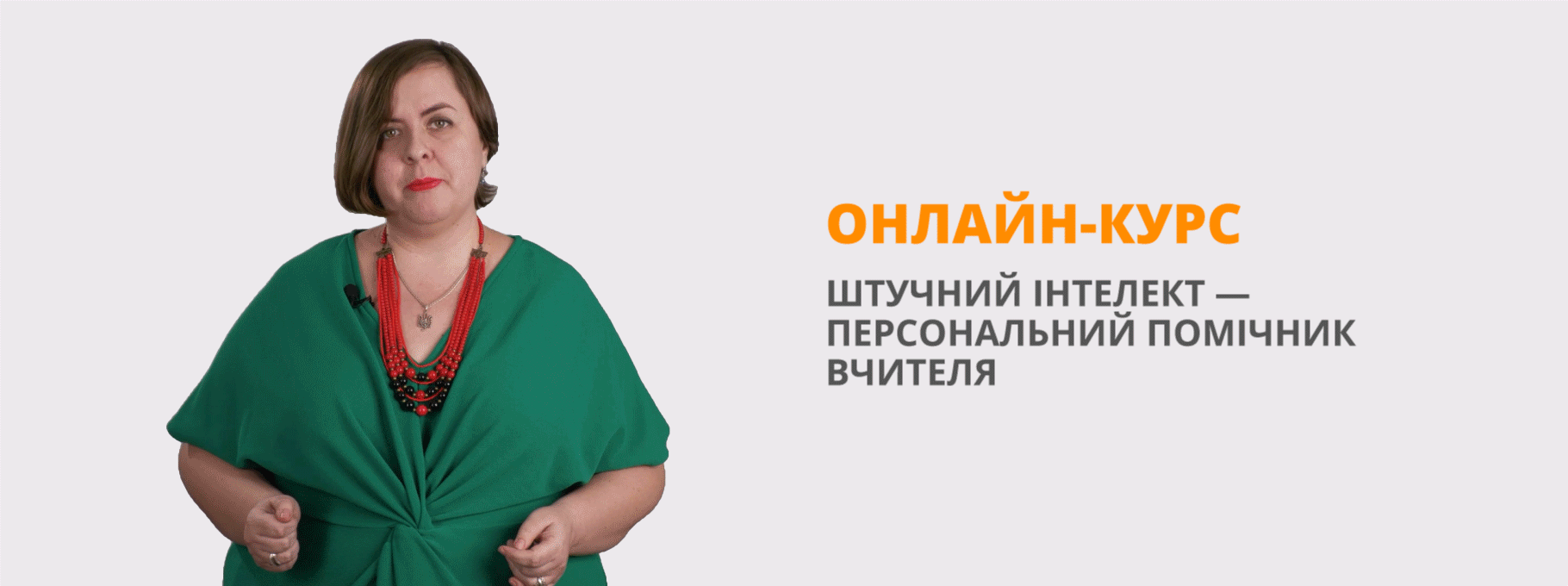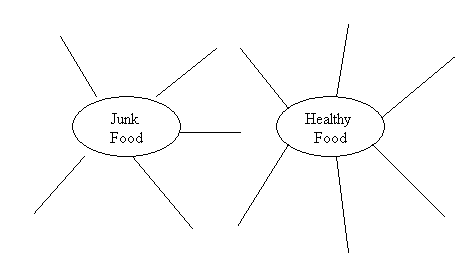Welcome to the World of Food!
ПЛАН-КОНСПЕКТ УРОКУ В 7 КЛАСІ
Тип уроку: Комбінований
Тема уроку: Welcome to the World of Food!
Підтема уроку: Healthy Food and Junk Food.
Цілі уроку:
- практичні:
- закріплення лексичних навичок, набутих під час вивчення теми «Їжа»
- актуалізація навичок писемного продукування на основі виконання творчих завдань;
- активізація навичок сприймання на слух;
- активізація навичок усного продукування на тему «Їжа» з використанням технології «дебати».
- освітня: розширити знання учнів про значення правильного харчування.
- розвиваюча: розвивати мовленнєву реакцію та аудіолінгвальні навички учнів.
- виховна: формувати культуру їжі в учнів, виховувати дбайливе ставлення до власного здоров’я.
Обладнання уроку: комп’ютер, CD-диски, роздатковий матеріал
|
Етап Мета Прийом |
Зміст уроку |
|||||||||||||||
|
Етап 1 Початок уроку. Мета: Організація класу Прийом: Привітання. Бесіда з класом
Етап 2 Мовленнєва зарядка
Мета: Введення учнів у мовне середовище Прийом 1: Повторення засвоєних ЛО по темі «Їжа»
Етап 3 Робота в режимі «вчитель-клас»
Мета: Узагальнення попереднього етапу. Стимулювання розвитку власної думки учнів через запитання. Прийом: Постановка запитань, що вимагають критичного мислення
Етап 4 Активне слухання Мета: Активізація навичок сприймання на слух та писемного продукування в учнів
Прийом 1: Прослуховування тексту «Nutrition Expert»
Прийом 2: Письмова класифікація ЛО по темі.
Етап 5 Письмо Мета: Активізація навичок писемного продукування на основі творчого завдання Прийом: Виконання вправи творчого х-ру
Етап 6 Створення асоціативних рядів з використанням вивченої лексики Мета: Розвиток і активізація навичок асоціативного мислення учнів Прийом: Застосування комунікативної технології «мозковий штурм»
Етап 7 Усне продукування на тему «Welcome to the World of Food» Мета: Розвиток і активізація навичок усного продукування та креативного мислення Прийом: Усне продукування учнів з використанням інноваційної технології дебатів
Етап 8 Підсумок уроку Завершення уроку
Мета: Підсумувати роботу на уроці Прийом: робота в режимі «вчитель-клас», бесіда з класом
|
T: Hello, pupils! I hope you’re fine today and I’m glad to see you. Today we’ll revise the topic which you’ve been studying during this time and we’ll summarize everything. During the lesson we’ll pass the following stages: vocabulary practice, listening activities, creative writing, brainstorming ideas, debates, summing up. (The cards with stages cover the motto of the lesson) So, welcome to the world of food!
Ps: Good morning, teacher! We are glad to see you too.
T: Ok, you’ve learned a lot of products and kinds of food, so, first let’s remind some of them.
T: Now name the products which were shown in the Power Point presentation.
Ps: mushrooms, parsley, grapes, broccoli, fruit salad, peas, courgette, aubergine, kiwi fruit, spinach, nuts, garlic, beans, cucumber, biscuit, fruit jelly, marmalade
T: Which of these products are good for our health? Which are harmful for us and why? Prove your point of view.
(expected students’ answers:) Ps: To my mind, all the fruit and vegetables supply us with many vitamins and I think we should eat them every day to be healthy and strong. Ps: It seems to me that fruit jelly, biscuit, marmalade and other sugary food add extra calories to our diet. Sugar gives you energy but has no other benefits, it rots your teeth and too much of it makes you overweight.
T: And now we’ll listen to the text “Nutrition Expert”. And your task is to fill in the missing information in the chart. Let’s start. It is very important to eat the right food, and to get the right balance of vitamins in our diet. For example, vitamin A, which we get from eggs, milk, fruit and green vegetables, is necessary for our growth and for healthy skin and eyes. Another good example is vitamin C. We get vitamin C from green vegetables, fruit, and potatoes. We need vitamin C for healthy skin, bones and muscles. Food and drink also provide us with lots of important minerals – calcium and iron, for example. We get calcium from milk and cheese. Calcium is important for building healthy teeth and bones. As for iron, we get that from liver, meat, fish, cereal, and green vegetables. Iron helps to keep our blood healthy.
T: I think that this work was successfully done and it is useful for you. Let’s pass the other stage – “creative writing”.
Chose from these words to complete the sentences below. One of these words can be repeated twice and one isn’t used at all. You have to insert them instead of dashes. Instead of dots you have to place either words “healthy food” or “junk food”. It’s your decision what to place according to your mind. You can use these expressions in the debates. to than too also both and junk food healthy food
Example: 1. I like healthy food and junk food.
T: So let’s summarize: what ideas do you have when you hear the words junk food and healthy food. Let’s make an association map. You’ll work in groups. The 1-st group will present the junk food and the other group will make the association map of healthy food.
Ps: Healthy food: vitamins, proteins, carbohydrates, slim and strong body, fruit and vegetables…..
T: And now we are ready to begin our debates.
T: OK. I liked your ideas very much. But you see, your ideas are all different because so many men so many minds. The same is with food that we eat. Some of us pay attention to the meals we eat and some of us prefer to have quick snacks. Depending on our lifestyle, our work and our tastes we eat at home or we can go to some diner or snack bar and eat there. Nowadays fast food restaurants are becoming very popular but as you’ve already heard food in such places is not healthy or may be not of good quality. So what is better: to eat healthily or quick and in a convenient time? As there are supporters and opponents of eating junk food, let’s find out who supports junk food? Who is against it? And of course every time there are some people who are neutral to the problem, are there such people here? Ok, now the team of junk food eaters will seat here and healthy food eaters will seat there. Those whose position is neutral will take this place. Now let’s make debates. Do you know what debates are? We’ve got different representatives here: businessman, doctor-nutritionist, actress, sportsman, police woman, also we have journalists and correspondents whose task is to note some facts and you’ll sum up everything in the end. Is it clear?
Possible ideas: P1: I’m a police woman and I prefer fast food because it’s a part of modern-day life and it’s convenient for me. I usually buy a hamburger, French fries and a drink to eat in or take away. Finger food makes most fast food and can be eaten without forks and knives. This food is usually served in cartons or bags or in a plastic wrapping. Fast food places often have a drive-through service which lets me order and pick up food from car which is very convenient for me and I like it.
P2: I’m a doctor and I’m against eating junk food. Fast food is often highly processed and prepared in an industrial way: with standard ingredients and standard cooking methods. It is often high in fat and sugar and low in vitamins and minerals. Another bad thing is that people eat fast food in a hurry. They eat more when they are in a hurry. That’s why they are overweight which is bad for their health.
P3: I’m a businessman and I prefer fast food. Such convenient foods which include canned foods, frozen dinners and precooked meat need little or no preparation and help me to save my time. Fast food means quick service, innovations in operations and products.
P4: I’m a sportsman and eating healthy food is a part of my life. Junk food usually has lots of empty calories that’s why it is harmful for me. Such food is very low on proteins, vitamins and fibre. Since junk food is high in fats and sugars, it leads to obesity, dental problems, heart diseases, etc. To be healthy and strong a person needs minerals, proteins, vitamins and certain fats to regulate body functions. Proteins, fats and carbohydrates give energy and heat. Normal diet, or balanced diet, contains all the food elements needed to keep us healthy, varied food, and minimal amounts of sugar, fat and salt. Ps: ……
T: Well done! So is it better to eat junk food or healthy food? Ps: ……. T: Good, we’ve passed all the stages of our lesson and now look at the blackboard and read the motto “We eat to live not live to eat”. (While passing the stages we take the cards away from the blackboard, and till the end of the lesson the motto is uncovered) What does it mean?
P: To my mind the food that we eat every day must be only the means of keeping fit and the source of energy but not the way of life.
T: Well done! Your home task is to write about your attitude to the food. And your marks for the lesson are:…. So our lesson is over, have a nice day! See you tomorrow! Bye! Ps: Good bye! |


про публікацію авторської розробки
Додати розробку

